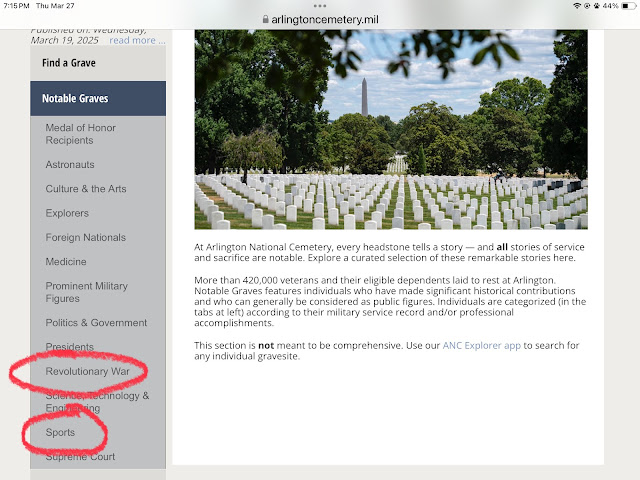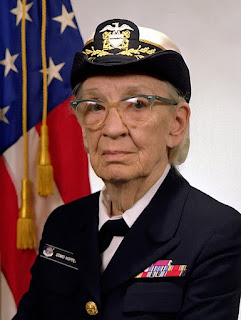In early March 2025, numerous media outlets reported that the names and histories of Black and Hispanic veterans and women veterans had been removed from the Arlington National Cemetery website.
In response, the Cemetery posted on its website that they were “updating” their website to comply with DoD and executive branch instructions. They wanted us to know that “no service members have been permanently removed from the “Notable Graves” section of our website” - which as of March 27, 2025 had removed sections for African Americans, Hispanic Americans, and Women from their “notable graves” categories. These existed as of January 8, 2025 (below).

Are the bios of women and people of color still there? Sure. But, as they were before the Civil Rights movement and the women’s movement of the 1960s/1970s, they’ve been tucked away again. Well, fuck that. Elizabeth Smith Friedman was known as “America’s first female cryptanalyst.” Her pioneering work in the field of codebreaking helped the country through pivotal moments in the 20th Century. A career that started with decrypting Shakespeare’s plays turned into cracking thousands of codes and ciphers during World War I, Prohibition, and World War II using only pencil and paper. Her contributions, even as they were overlooked during her lifetime, set the stage for generations of codebreakers to come. Smith Friedman was one of the first women employed as a U.S. government codebreaker. After graduating from Hillsdale College with a degree in English literature, she was working at the Newberry Research Library in Chicago when she was recruited to work at Riverbank, a private think tank that served as the U.S. government's unofficial cryptologic laboratory during World War I. During the 1920s through 1940s, she worked for numerous U.S. government agencies, including the Treasury Department, where she cracked the codes of international alcohol and drug smugglers' messages during Prohibition. In the 1950s, she applied her cryptanalytic skills to the work of William Shakespeare, authoring the award-winning book "The Shakespeare Ciphers Examined." (Section 8, Grave 6379-A)
Elizabeth Smith Friedman was known as “America’s first female cryptanalyst.” Her pioneering work in the field of codebreaking helped the country through pivotal moments in the 20th Century. A career that started with decrypting Shakespeare’s plays turned into cracking thousands of codes and ciphers during World War I, Prohibition, and World War II using only pencil and paper. Her contributions, even as they were overlooked during her lifetime, set the stage for generations of codebreakers to come. Smith Friedman was one of the first women employed as a U.S. government codebreaker. After graduating from Hillsdale College with a degree in English literature, she was working at the Newberry Research Library in Chicago when she was recruited to work at Riverbank, a private think tank that served as the U.S. government's unofficial cryptologic laboratory during World War I. During the 1920s through 1940s, she worked for numerous U.S. government agencies, including the Treasury Department, where she cracked the codes of international alcohol and drug smugglers' messages during Prohibition. In the 1950s, she applied her cryptanalytic skills to the work of William Shakespeare, authoring the award-winning book "The Shakespeare Ciphers Examined." (Section 8, Grave 6379-A)
In response, the Cemetery posted on its website that they were “updating” their website to comply with DoD and executive branch instructions. They wanted us to know that “no service members have been permanently removed from the “Notable Graves” section of our website” - which as of March 27, 2025 had removed sections for African Americans, Hispanic Americans, and Women from their “notable graves” categories. These existed as of January 8, 2025 (below).

Interestingly, the categories listed now don’t follow an organization, as the Cemetery claims, “by military service record and/or professional accomplishments”. They spotlight American Revolution soldiers, and Sports figures, because it’s important to be able to easily learn about those figures but not women or service men and women of color.
Are the bios of women and people of color still there? Sure. But, as they were before the Civil Rights movement and the women’s movement of the 1960s/1970s, they’ve been tucked away again. Well, fuck that.
Introducing Elizabeth Smith Friedman and Grace Hopper, two U.S. women in STEM buried at Arlington National Cemetery.

Grace Hopper, U.S. Navy Rear Admiral. Rear Admiral Hopper was a mathematician and a pioneer in computer science. At a time when few women pursued science or engineering degrees, Hopper earned her Ph.D. in mathematics from Yale University in 1934. She was a professor of mathematics at Vassar College (her undergraduate alma mater) until 1943, when she joined the U.S. Naval Reserve (Women's Reserve). After graduating from midshipman's school, she was commissioned as a lieutenant junior grade. Assigned to the Bureau of Ships Computation Project at Harvard University, Hopper worked on Mark I, the first large-scale fully automatic calculator (a precursor of the computer). After the war, she remained at the Harvard Computation Lab for four years as a research fellow. In 1949, Hopper joined the Eckert-Mauchly Computer Corporation, where she helped to develop the UNIVAC I, the first general-purpose electronic computer. She retired from the Naval Reserve in late 1966, but was recalled to active duty less than a year later, in August 1967. From 1967 to 1977, she directed the Navy Programming Languages Group in the Navy's Office of Information System Planning. When Rear Adm. Hopper retired from the Navy in 1986 at the age of 79, she was the oldest commissioned naval officer on active duty. (Section 59, Grave 973)
Be sure to dive deep into the histories on the Arlington National Cemetery’s website. The women and service men and women of color were kickass individuals, whose contributions to America deserve better than to be hidden. Because let’s be fucking for real - they had to work harder and smarter to get where they did and they deserve to be celebrated for that.
(Elizabeth Smith Friedman photo: Wikipedia. Bio sources: Arlington National Cemetery and National Women’s History Museum, Grace Hopper photo: Wikipedia. Bio: Arlington National Cemetery.)




Comments
Post a Comment